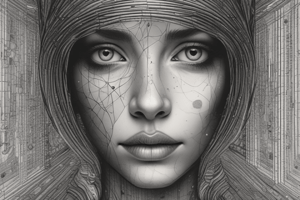Podcast
Questions and Answers
What is a significant challenge in designing a perceiving machine related to visual input?
What is a significant challenge in designing a perceiving machine related to visual input?
- Visual input provides consistent information about 3D structures.
- All objects in a scene are uniformly illuminated.
- 2D retinal images can result from multiple 3D configurations. (correct)
- Computers can easily differentiate between distinct objects.
How does image complexity affect machine perception?
How does image complexity affect machine perception?
- It complicates the differentiation of distinct objects. (correct)
- It reduces the ambiguity of visual input.
- It simplifies the process of organizing visual scenes.
- It enhances the resolution of detected edges.
What is one approach to understanding perceptual organization mentioned?
What is one approach to understanding perceptual organization mentioned?
- Cognitive Mapping
- Functionalism
- Gestalt Theory (correct)
- Structural Analysis
What is a learning objective related to perceiving depth?
What is a learning objective related to perceiving depth?
What role do ambiguous visual inputs play in our perception?
What role do ambiguous visual inputs play in our perception?
What type of disparity occurs when objects are closer than the horopter?
What type of disparity occurs when objects are closer than the horopter?
Which depth cue relies primarily on the visual information provided by a single eye?
Which depth cue relies primarily on the visual information provided by a single eye?
Who were the central figures in the development of the Gestalt school of thought?
Who were the central figures in the development of the Gestalt school of thought?
What is the main argument of the Gestalt school regarding perception?
What is the main argument of the Gestalt school regarding perception?
What depth cue involves changes in object size perceived with distance?
What depth cue involves changes in object size perceived with distance?
What is the process of extracting depth information from binocular disparities called?
What is the process of extracting depth information from binocular disparities called?
What role does prior knowledge play in depth perception?
What role does prior knowledge play in depth perception?
What describes the position of images from the perspective of the right eye for uncrossed disparity?
What describes the position of images from the perspective of the right eye for uncrossed disparity?
What is the primary focus of the Gestalt principles of perceptual organization?
What is the primary focus of the Gestalt principles of perceptual organization?
Which principle states that elements that are close together tend to be perceived as belonging together?
Which principle states that elements that are close together tend to be perceived as belonging together?
What does the Law of Prägnanz suggest about perceptual organization?
What does the Law of Prägnanz suggest about perceptual organization?
Which Gestalt principle allows individuals to perceive a complete figure even when it is incomplete?
Which Gestalt principle allows individuals to perceive a complete figure even when it is incomplete?
What does the principle of common fate indicate?
What does the principle of common fate indicate?
Which principle emphasizes the importance of continuity in perception?
Which principle emphasizes the importance of continuity in perception?
Which principle is suggested to play a role in balancing and symmetry in perception?
Which principle is suggested to play a role in balancing and symmetry in perception?
What is one criticism of the Gestalt principles mentioned?
What is one criticism of the Gestalt principles mentioned?
Which aspect of perception does the principle of similarity address?
Which aspect of perception does the principle of similarity address?
What is a commonality observed in the Gestalt principles?
What is a commonality observed in the Gestalt principles?
What function does relative height serve in depth perception?
What function does relative height serve in depth perception?
Which monocular cue involves objects blocking the view of other objects?
Which monocular cue involves objects blocking the view of other objects?
What is the primary difference between monocular cues and binocular cues?
What is the primary difference between monocular cues and binocular cues?
What happens to parallel lines as they extend into the distance, according to linear perspective?
What happens to parallel lines as they extend into the distance, according to linear perspective?
How does motion parallax contribute to depth perception?
How does motion parallax contribute to depth perception?
What is meant by binocular disparity?
What is meant by binocular disparity?
What is foreshortening in the context of depth perception?
What is foreshortening in the context of depth perception?
What factors contribute to the perception of depth through shadows?
What factors contribute to the perception of depth through shadows?
What are horopter points in the context of binocular vision?
What are horopter points in the context of binocular vision?
What is texture gradient and how does it contribute to depth perception?
What is texture gradient and how does it contribute to depth perception?
Flashcards
Depth Perception
Depth Perception
The ability to perceive the three-dimensional world from two-dimensional retinal images.
Visual Ambiguity
Visual Ambiguity
A source of ambiguity in visual perception where multiple 3D objects can produce the same 2D retinal image.
Visual Scene Complexity
Visual Scene Complexity
A challenge for designing perceiving machines, where image complexity makes object segregation difficult.
Structuralist Approach
Structuralist Approach
Signup and view all the flashcards
Gestalt Approach
Gestalt Approach
Signup and view all the flashcards
Binocular disparity
Binocular disparity
Signup and view all the flashcards
Crossed Disparity
Crossed Disparity
Signup and view all the flashcards
Uncrossed Disparity
Uncrossed Disparity
Signup and view all the flashcards
Horopter
Horopter
Signup and view all the flashcards
Stereopsis
Stereopsis
Signup and view all the flashcards
Structuralism
Structuralism
Signup and view all the flashcards
Gestalt School
Gestalt School
Signup and view all the flashcards
Wilhelm Wundt
Wilhelm Wundt
Signup and view all the flashcards
Relative height
Relative height
Signup and view all the flashcards
Relative size
Relative size
Signup and view all the flashcards
Occlusion
Occlusion
Signup and view all the flashcards
Linear perspective
Linear perspective
Signup and view all the flashcards
Texture gradient
Texture gradient
Signup and view all the flashcards
Motion parallax
Motion parallax
Signup and view all the flashcards
Shadows and shading
Shadows and shading
Signup and view all the flashcards
Stereoscopic vision
Stereoscopic vision
Signup and view all the flashcards
Illusory Contours
Illusory Contours
Signup and view all the flashcards
Gestalt Principles
Gestalt Principles
Signup and view all the flashcards
Law of Pragnanz
Law of Pragnanz
Signup and view all the flashcards
Proximity
Proximity
Signup and view all the flashcards
Similarity
Similarity
Signup and view all the flashcards
Common Fate
Common Fate
Signup and view all the flashcards
Good Continuation
Good Continuation
Signup and view all the flashcards
Closure
Closure
Signup and view all the flashcards
Symmetry
Symmetry
Signup and view all the flashcards
Assessment of Gestalt Principles
Assessment of Gestalt Principles
Signup and view all the flashcards
Study Notes
Cognitive Psychology 1 - Perception III: Depth and Visual Scene Analysis
- Course: PSGY1010
- Lecturer: Dr Chung Kai Li
- Institution: University of Nottingham (UK, China, Malaysia)
Visual Scene Analysis
- Visual input provides ambiguous information about 3D world structure.
- The same 2D retinal image can correspond to an infinite number of 3D objects.
- This ambiguity is exploited by artists in anamorphic street art.
- Image complexity makes computer scene analysis difficult.
- Computers struggle to organise visual scenes into distinct objects.
How Do We Perceive Depth?
-
Humans use various image information sources to infer depth.
-
Monocular Cues (using one eye):
- Relative height
- Relative size
- Occlusion
- Linear perspective
- Texture gradient
- Motion parallax
- Shadows
- Shading
-
Binocular Cues (using both eyes):
- Disparity
Relative Height and Size
- Objects below the horizon with higher bases are perceived as more distant.
- If two objects are of equal physical size, the more distant one appears smaller in the visual field.
Occlusion
- Closer objects block the view of further objects.
Linear Perspective and Texture Gradient
- Parallel lines appear to converge in the distance.
- Texture elements become smaller and denser with distance.
- Fore-shortening (circles becoming ovals) occurs when a tilted surface recedes away.
Motion Parallax
- As we move, more distant objects appear to move past more slowly than closer objects.
Shadows and Shading
- Brightness of a surface depends on its orientation relative to the light source.
- Cast shadows contribute to depth perception.
Binocular Disparity
- Our two eyes receive slightly different images of the world.
- This difference in image location (disparity) provides depth information.
- The greater the disparity, the closer the object.
- Horopter: The set of points in space that project to corresponding points on the two retinas (zero disparity).
How Do We Perceive Objects?
-
Structuralism:
- Wilhelm Wundt pioneered this approach, popular in the mid-to-late 19th century.
- Proposed that perceptions are the sum of basic sensory elements.
-
Gestalt Psychology:
- Reaction against structuralism.
- Key figures: Wertheimer, Köhler, and Koffka.
- Argued that the whole is greater than the sum of its parts.
- Emphasized perceptual organisation principles.
Gestalt Principles of Perceptual Organisation
- Proximity: Things close together are grouped together.
- Similarity: Similar things are grouped together.
- Common Fate: Things moving together are grouped together.
- Good Continuation: Elements are grouped to form smooth lines, avoiding abrupt changes.
- Closure: Incomplete figures are perceived as complete.
- Symmetry: Balanced or symmetrical elements are grouped together.
Summary
- Key objective: Analyze how we determine depth from 2-D images, and compare and discuss the Structuralist and Gestalt approaches.
- Both monocular and binocular cues are significant for perceiving depth.
- Perception of depth involves a combination of bottom-up and top-down processes. Depth cues combine to produce our perception.
- Both structuralism and Gestalt principles have contributed to our understanding of perceptual organization and object grouping, but are distinct.
Studying That Suits You
Use AI to generate personalized quizzes and flashcards to suit your learning preferences.




